I found this 1950s-era Canadian military radio in an online Goodwill auction, of all places. It is missing its whip antenna, but a friend in Australia is helping me out with that. This one may be tricky to repair if it doesn’t already work, because all but one of the vacuum tubes are hermetically sealed into individual metal cans. The modular construction made these easy to repair in service, but I don’t have a stock of spare modules to draw from. Updated 2020-09-15: Added manual scans.
Oddly, the -3V battery pin is covered with a rubber plug. The plug seems to be firmly bonded to the rubber battery connector insulator, so I don’t want to pull it off until I’m sure that it doesn’t belong there. This is a mystery that I hope that other CPRC-26 fans can help me figure out. I later found that it pulls off and clearly doesn’t belong there.
It’s a bit surprising that this is my first CPRC-26. It just seems like a radio that I should have acquired many years ago, but it took me this long to get around to buying one.
The radio came with five out of six channel crystals installed, but two are duplicates. Unfortunately, none of them are for 51.0 MHz, the single most used channel for US ham radio operators who collect VHF low-band military FM radio gear. I think I’ve read that the CPRC-26 uses the same crystals as the US AN/PRC-6 radio.
The handset is very similar to the US H-33/U handset, but with a bakelite piece bonded on the outside of the rubber PTT switch boot, and a different connector. The PTT switch piece is cracked, so I’ll need to repair or replace it.
Three of the bottom case screws are missing. They’re sealing type screws with little O-rings in recesses under the heads. The top of the case is secured with four clamps. Two of them had fallen off in shipping, but luckily I found them in the packing material before I threw away the shipping box.
2020-09-15 update:
Since I orginally made this blog post, I’ve gotten my hands on the crystals and accessories that I’ll need to restore this radio. I just need to make a battery pack or adapter for it.
Here are some technical manual scans which have been sent to me and/or I’ve found online. I hope they will help other CPRC-26 collectors who may stumble onto this page.

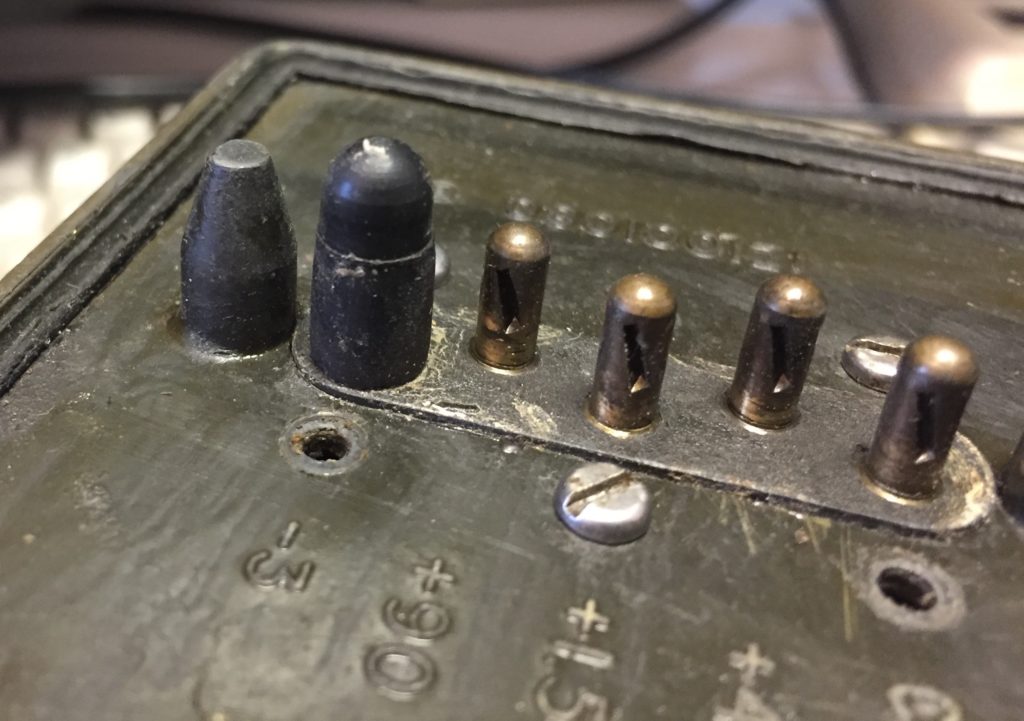
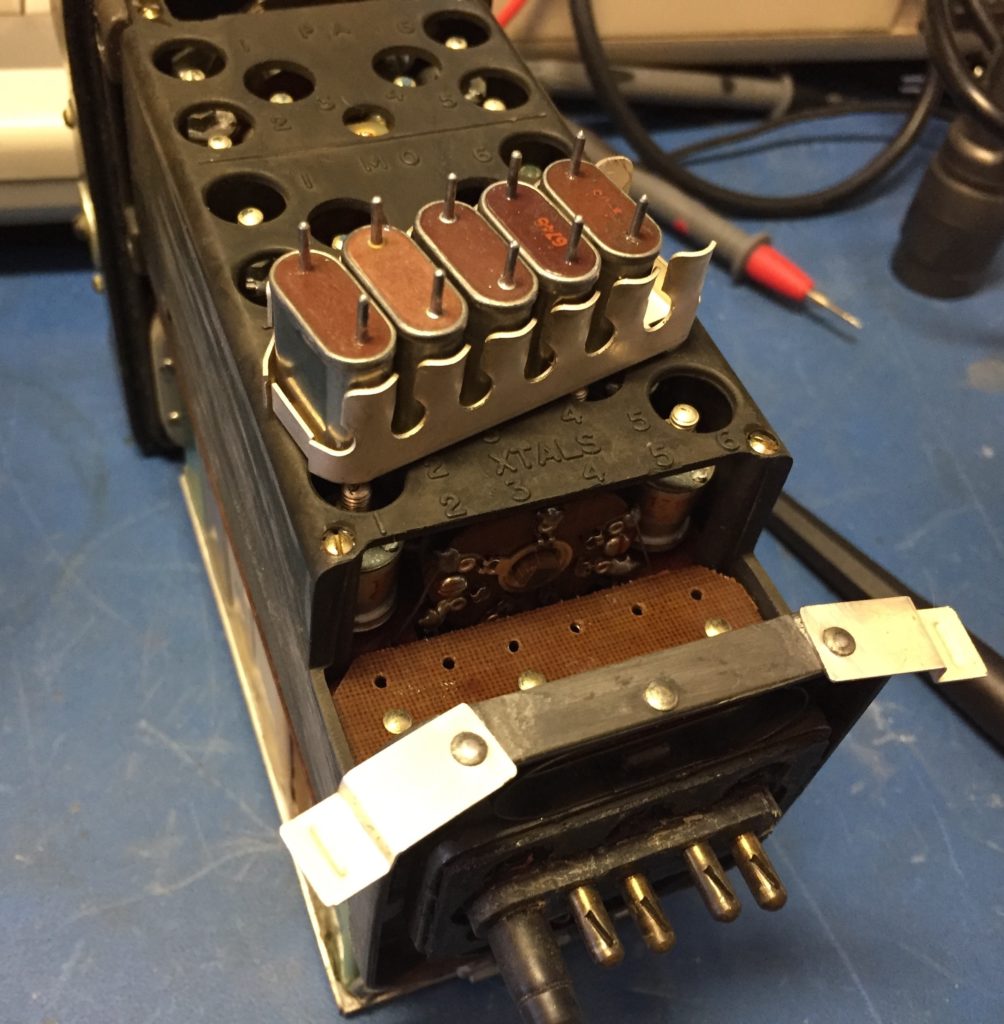





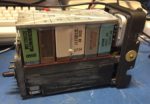





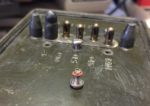











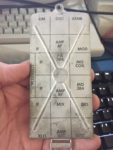
I have spare modules, if you nned them
Thanks!
Mark,
Interesting. The only sets listed with a 51.0 MHz frequency are the Type B and C which were not used, and the Type D. The Yellow dot indicates a Type D with the following channels: 50.0, 50.2, 50.4, 50.6, 50.8 and 51.0 MHz. The crystals in this radio are set to 51.8, 56.4 and 65.05 MHz (crystal frequency + IF of 4.3 MHz). And two of these frequencies are in pairs. Could this be the reason for the capped power pin?
The manual lists the frequency range as between 47.0 MHz and 55.4 MHz.
If you are interested, I most of the manuals. My e-mail address is cmp.truck@gmail.com. I can send you scanned copies.
Ian
VA6SSV
I think that I remember reading that late versions had an all solid state audio module thus eliminating the need for the -3v bias.
Neat!
I did end up pulling off the cap on the -3V pin. It wasn’t molded or glued in place as I originally thought; it was just crammed down tight on the pin, such that the seam wasn’t very visible under the years of gunk. SO maybe it was there for a reason, or maybe it was just crammed on there for no particular reason. Maybe I’ll learn more once I get around to studying my set’s electronics more carefully?
Craig,
Philips developed a solid state model for the Danish army. It is called the PRC-261 and had twelve channels rather than six.
Mark,
I am not a radio expert by any means, but if the top of the frequency range for this radio is 55 MHz, and this radio operates above this frequency, does this mean a modification was made to allow operating on 56.4 MHz and 65.05 MHz?
Ian
I don’t know about this CPRC-26 yet. I have used other crystal-controlled radios outside of their specified ranges, such as an EF Johnson Fleetcom II that I repurposed for use on the US 440 MHz ham band back in the 1990s. The specified frequency range often isn’t a hard limit.
I am looking for a spare CPRC-26 whip antenna to replace a damaged one on my unit can any one help
Brian
Hi,
I am from the Netherlands and looking for a battery.
Gr Maurice
Hi mark just picked one of these up at a hamfest for $20 dollars.Mine is ser. Number 18413 only 162 from yours it currently has 50.0 MHz in it. some one has made their own battery years ago the inside is pretty pristine the outer casing is well corroded but should clean up.you know any tricks for these?73’jim KB1PFL
Congratulations! Nice price. I don’t know any tricks off the top of my head. I haven’t made a battery for mine yet. If I recall correctly, the pins appear to be made of brass?
Jim,
Basically, these radios were produced as an intact radio set without any crystals installed. When the radio was assigned to its specific user, the crystals were then installed and an alignment done for peak operation.
2500 were made for the British army before they started production of the A40. Phillips made some for the Dutch army (model XN) and modified the set to produce the PRC-261 with twelve channels.
If you have a 50.0 Mhz crystal it could be any version as 50.0 Mhz is the common frequency on channel one.
The most commonly seen sets are the A, red dot, and the D, yellow dot. Some types were not issued as the tactical requirements of the Canadian army changed over time. So B and C were not used. If I recall they these were the carrier platoon and the anti-tank platoon.
There aren’t really any “tricks” for these sets. One important issue: the set must be aligned if new crystals are installed. So assuming you have an A set or a C set, you must use the crystals associated with that radio. The lack of squelch is a pain. I know old sigs guys who insist their hearing loss is due to constant use of this set.
There is a battery adapter, BA-281 (??), but I have only seen two of these. They required 9v, 3v and 1.5 v batteries. I have one and they use a lot of batteries. There is a guy in Italy on epay who sells an inverter for the set. I have one for the PRC-10 which works fine. I haven’t used the CPRC-26 inverter yet.
Regards,
Ian Coope
Hi
A’m an militaria colector and looking for a battery
a’m living in Belgium
crt-1/cprc-26 serial number 25313 1954
made by: rogers Majestic Canada
my name: André
mail: andre.reyntiens007@gmail.com
hey. i just picked one up through ebay and am wanting to know how to power this for testing. is there a way to use modern batteries so i don’t have to search through the depths of the internet to find a battery for a 1953 canadian radio? also do the 45V and 90V work independantly with the loud/quite, or am i just thinking of how things work really stupidly? kinda new to radio stuff, but into mid-late 20th century military stuff. (mostly korea/vietnam conflict era)
Hi there! I have not tried powering up my CPRC-26 yet, but I hope to get around to that “sometime this year”. I found some crimp-on terminals that are the right size for connecting to the male pins on the bottom of the radio: McMaster-Carr part number 71285K11, marked on the bag as Molex part number 190370019. They are non-insulated 0.156″ female “bullet” terminals. I expect to build my own connector and battery box. 3D printing will probably be involved.
I have not studied the schematic carefully recently, but usually for similar radios of this era such as AN/PRC-10:
I haven’t tried balancing battery capacities or figuring out what I can fit in a battery box yet… For my initial bench testing at least, I’d probably use:
I hope this helps. Good luck!
I have a 3D battery box for it on Thingiverse.
https://www.thingiverse.com/thing:1631729
Cool!
Jerry,
Attached is a file for making a battery. I have the BA-289/U adapter so I haven’t built the attached style of battery. They are of the same construction type, but the BA-289 frame is aluminium. I last message that I read, the Italian fellow who makes the inverter is not doing to well as he is in the midst of recovering from the corona virus. He may start to produce the inverters once he is well again.
Oh, I just noticed there appears no way to add a file. If you want the file send me your e-mail.
Ian
If you send me the file, I can put it up on this page. Jerry has also asked me about getting a handset.
Thanks everyone for the support and information on some of this stuff! I’m interested in finding out how the handset functions or simply where I can get one, I really like this radio and the one I picked up seems to be in pretty good condition. I do agree with Mr. Blair, the owner of the site, i feel it would be best to send the file to him so he can post it for everyone to see.
Aha! I recognize the diagram as a scan from the book Power Up!: How To Make Battery Adapters For Military Radios by Dave Strom. I think it’s long out of print, but I don’t think I should publicly post the scan here.
I’ve been looking for a copy of that book to no avail. If you still have it is it possible to buy a scanned copy from you? Thanks either way.
Email: Kreggied@aol.com
Sorry, I can’t help with that.
If you can find a schematic for the US Handset H-33(PT) that will give you info on the innards of the handset itself. The use of an ohmmeter to check for continuity will help you identify which pin does what. The US PRC-6 service manual has a good breakdown of the H-33(PT). If that manual is not already posted on this site then try a search for “radionerds” Hope this is helpful. CRAIG N3TPM
I have a spate CPRC-26 handset if you need one
Brian VK2FBKT..
Hey, you say you have a spare handset? I’d like to get in contact with you somehow, I’m interested in purchasing it. If there’s any way we can exchange some sort of info that’d be great!
Sure thing my email is brian.thompsonvk2fbkt@gmail.com am willing to sell swap horetrade let me know
Brian
VK2FBKT
Hey I sent you an email about the handset yesterday, just wanted to make sure you got it and it didn’t send to spam or anything. Should be from a gmail.com
Jerry,
I didn’t get an e-mail from you. I gather you sent one to Brian.
Ian
Oh yes sorry, I figured out how to power it and store the batteries in a box, thanks for the help though!
Does anyone have a service manual/pdf for this radio. Finally have all the parts…..but need to test it..??